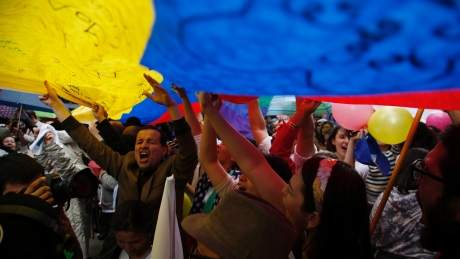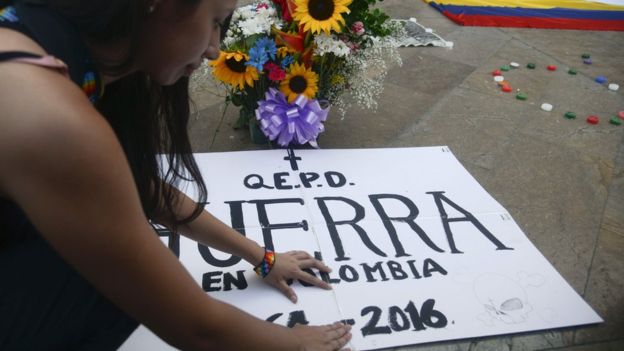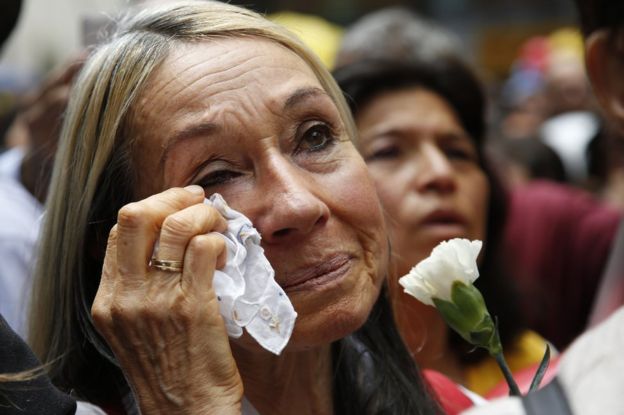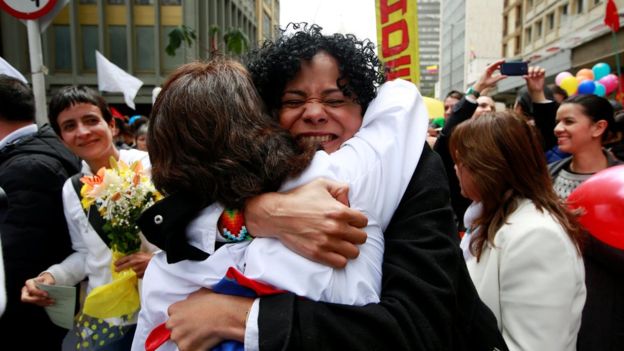Colombia Farc: Celebrations after ceasefire ends five decades of war
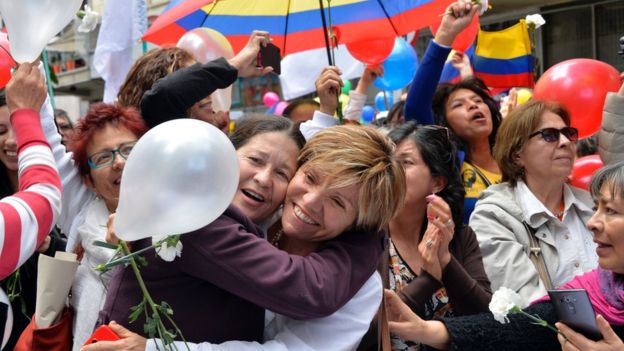
Colombians are celebrating the signing of a ceasefire by the government and the Farc rebel movement, which ended 50 years of civil war.
In the capital, Bogota, people took to the streets, hugging each other and singing the national anthem.
The announcement is seen as one of the last steps before a full peace deal is signed, which is expected within weeks.
The longest-running insurgency in the Western hemisphere left some 220,000 people dead and millions displaced.
Thursday's announcement in Havana caps formal peace talks that started three years ago in the Cuban capital.
But it does not mark the start of the ceasefire, which will only begin with the signing of a final accord.
Colombia's President Juan Manuel Santos has previously said he hopes to sign that by the end of July.
The Farc in the 21st Century is a strange beast.
Gone is the bipolar vision of the Cold War, and gone too are most of the group's original intellectual architects, many killed in combat.
Today, somewhat anchorless, the rebels continue to go through motions of an armed insurgency but they know a new future is beckoning.
They remain primed for war — machine guns by their beds, handguns under their pillows, all night lookouts keeping watch for an enemy that no longer seems to be searching for them.
Thursday's announcement included:
A commitment that rebels will lay down arms within 180 days of a final peace deal
The creation of temporary transition zones and camps for the estimated 7,000 rebels
A provision that no civilians will be allowed to enter Farc camps, to guarantee rebel security
A provision that UN monitors will receive all the group's weapons
"Let this be the last day of the war," Farc leader Rodrigo Londono, known as Timochenko, said at the announcement.
Both sides agreed to let the courts rule whether a popular vote can be held in Colombia to endorse the deal, which was a promise made by Mr Santos.
The president said at the ceremony that this was a "historic day".
"We have reached the end of 50 years of death, attacks and pain," he said. "This is the end of the armed conflict with the Farc."
The announcement of the Farc ceasefire dominated the headlines of the online editions of the main Colombian newspapers and other media outlets.
Centre-left newspaper El Espectador featured extensive coverage of the news of the agreement and a banner headline, which reads: "The guns went silent" along a striking image of two guerrilla fighters in action. It also covered the key points of the deal as well as the history of the conflict.
Conservative newspaper El Tiempo emphasised President Juan Manuel Santos's statement that the final agreement would be signed in Colombia, not Cuba.
Medellin-based newspaper El Colombiano featured a commentary by former President Alvaro Uribe, who remains sceptical about the prospects for peace, saying "the word peace is wounded".
One of the main national radio networks RCN ran a story citing Farc leader Timochenko saying: "We are going to do politics without arms."
Grey line
Who are the Farc?
The Revolutionary Armed Forces of Colombia (Farc, after the initials in Spanish) are Colombia's largest rebel group
The main enemy of the Farc have been the Colombian security forces. Farc fighters have attacked police stations and military posts, and ambushed patrols
They have been hit hard by the Colombian security forces over the past years
Both sides still need to establish how the peace deal in its entirety will be implemented, verified and approved.
UN Secretary-General Ban Ki-moon and leaders of Latin American countries also attended the ceremony.
The agreement was welcomed elsewhere, with the EU's foreign representative Federica Mogherini calling it "a turning point in the Colombian peace process".
US Secretary of State John Kerry said that "although hard work remains to be done, the finish line is approaching and nearer now than it has ever been".
Политика конфиденциальности | Правила пользования сайтом
